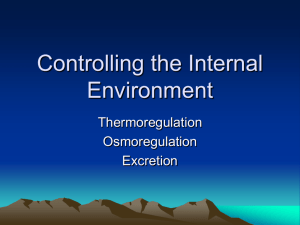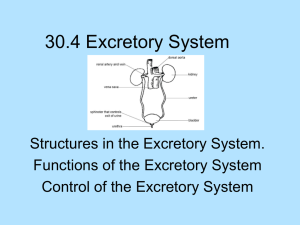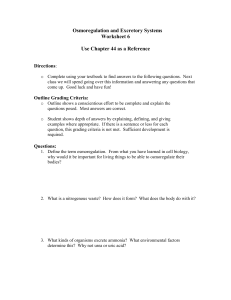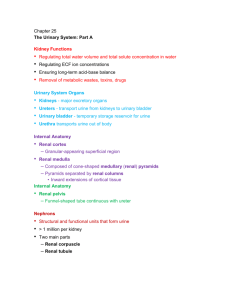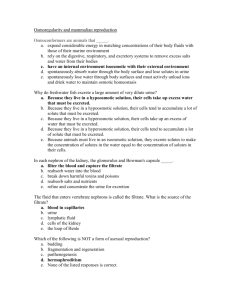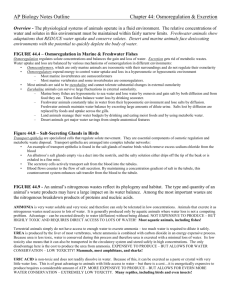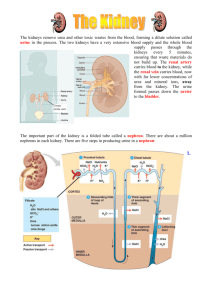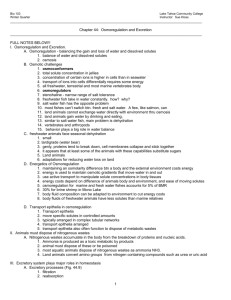Excretory System - TJHSST Activities
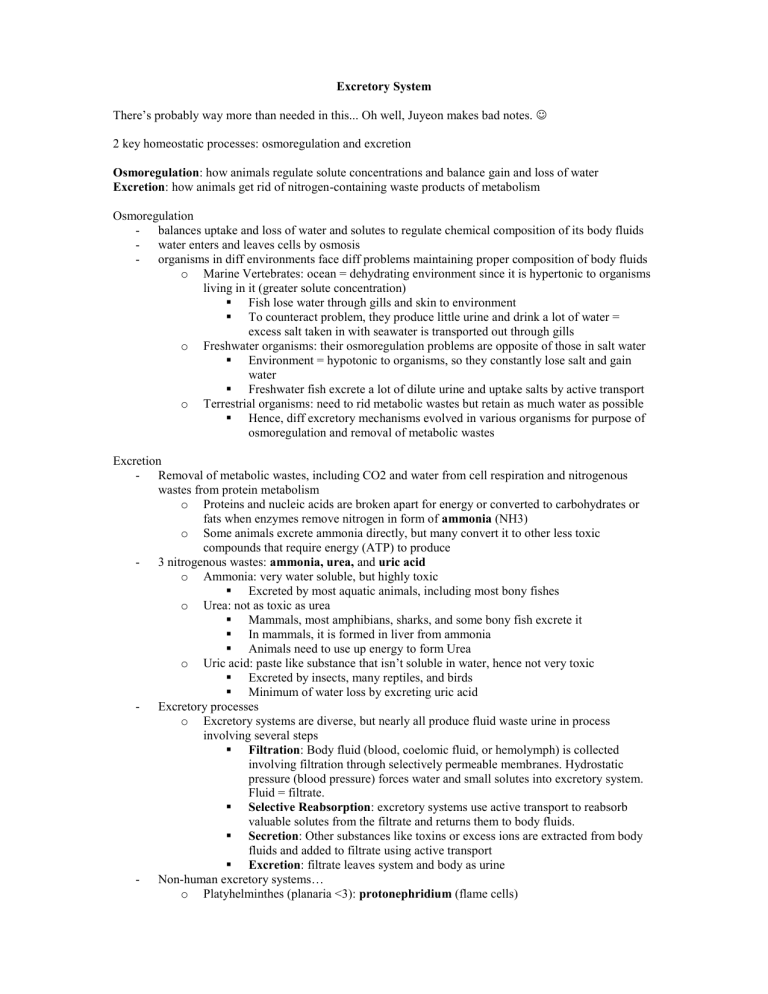
Excretory System
There’s probably way more than needed in this... Oh well, Juyeon makes bad notes.
2 key homeostatic processes: osmoregulation and excretion
Osmoregulation : how animals regulate solute concentrations and balance gain and loss of water
Excretion : how animals get rid of nitrogen-containing waste products of metabolism
Osmoregulation
balances uptake and loss of water and solutes to regulate chemical composition of its body fluids
water enters and leaves cells by osmosis
organisms in diff environments face diff problems maintaining proper composition of body fluids o Marine Vertebrates: ocean = dehydrating environment since it is hypertonic to organisms living in it (greater solute concentration)
Fish lose water through gills and skin to environment
To counteract problem, they produce little urine and drink a lot of water = excess salt taken in with seawater is transported out through gills o Freshwater organisms: their osmoregulation problems are opposite of those in salt water
Environment = hypotonic to organisms, so they constantly lose salt and gain water
Freshwater fish excrete a lot of dilute urine and uptake salts by active transport o Terrestrial organisms: need to rid metabolic wastes but retain as much water as possible
Hence, diff excretory mechanisms evolved in various organisms for purpose of osmoregulation and removal of metabolic wastes
Excretion
Removal of metabolic wastes, including CO2 and water from cell respiration and nitrogenous wastes from protein metabolism o Proteins and nucleic acids are broken apart for energy or converted to carbohydrates or fats when enzymes remove nitrogen in form of ammonia (NH3) o
Some animals excrete ammonia directly, but many convert it to other less toxic compounds that require energy (ATP) to produce
3 nitrogenous wastes: ammonia, urea, and uric acid o Ammonia: very water soluble, but highly toxic
Excreted by most aquatic animals, including most bony fishes o Urea: not as toxic as urea
Mammals, most amphibians, sharks, and some bony fish excrete it
In mammals, it is formed in liver from ammonia
Animals need to use up energy to form Urea o Uric acid: paste like substance that isn’t soluble in water, hence not very toxic
Excreted by insects, many reptiles, and birds
Minimum of water loss by excreting uric acid
Excretory processes o Excretory systems are diverse, but nearly all produce fluid waste urine in process involving several steps
Filtration : Body fluid (blood, coelomic fluid, or hemolymph) is collected involving filtration through selectively permeable membranes. Hydrostatic pressure (blood pressure) forces water and small solutes into excretory system.
Fluid = filtrate.
Selective Reabsorption : excretory systems use active transport to reabsorb valuable solutes from the filtrate and returns them to body fluids.
Secretion : Other substances like toxins or excess ions are extracted from body fluids and added to filtrate using active transport
Excretion : filtrate leaves system and body as urine
Non-human excretory systems… o Platyhelminthes (planaria <3): protonephridium (flame cells)
Network of dead-end tubules lacking internal openings
Functions mainly for osmoregulation o Earthworms: metanephridia (nephridia)
Has internal openings that collect body fluids
Have excretory and osmoregulatory functions o Insects: Malpighian tubules
Remove nitrogenous wastes and function in osmoregulation
-
Human excretory system (aka the important one…) o Centers on kidneys = principal site of water balance and salt regulation
Supplied with blood by renal artery and drained by renal vein
Urine
ureter
urinary bladder
urination
urethra
2 distinct regions: renal cortex and renal medulla
Nephron : functional unit of vertebrate kidney
Consists of single long tubule and a ball of capillaries ( glomerulus )
End of tubule forms a cup-shaped swelling =
Bowman’s capsule
, which surrounds the glomerulus o Basic pathway: blood in glomerulus
bowman’s capsule
filtrate
proximal tubule
loop of Henle
distal tubule
collecting tubule
renal pelvis o NOW MOR INDEPTH…. ALALALALLA…. o After everything is filtered in the bowman’s capsule filtrate goes to….
Proximal tubule
Secretion and reabsorption in proximal tubule substantially alter volume and composition of filtrate
Most of the NaCl and water from initial filtrate volume is reabsorbed into body fluid here
Descending limb of loop of Henle
Reabsorption of water continues
Freely permeable to water but not very permeable to salt and other small solutes
Makes filtrate increasingly more concentrated
Ascending limb of loop of Henle
Permeable to salt but not water
2 specialized regions o A thin segment near loop tip
NaCl diffuses out into interstitial fluid o A thick segment adjacent to distal tubule
NaCl is ACTIVELY transported into interstitial fluid
Filtrate becomes progressively diluted
Distal Tubule
Like proximal tube, important for secretion and reabsorption
Collecting duct
Collecting duct carries filtrate through medulla to renal pelvis
Tissue surrounding it is high in salt concentration
Additional water removal is dependent on presence of antidiuretic hormone (ADH) o If present: walls of collecting duct become permeable to water, and filtrate becomes hypertonic o If not, walls remain impermeable to water and urine remains hypotonic o ADH is released into blood when salt concentration becomes too high in blood o
If blood concentration is too dilute, ADH production is cut down and more urine is excreted o Alcohol blocks release of ADH, so more urination and dehydration o
ADH is produced in hypothalamus of brain and is stored and released by posterior pituitary
